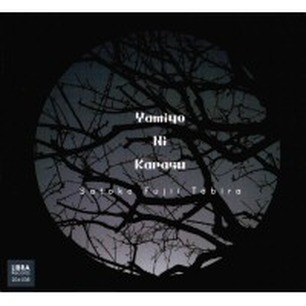
With what began as a trio on a world tour, a development occurred in 2013-14 as trumpet virtuoso Natsuki Tamura would join them often as guest artist in various places. Fujii, fluid as ever, abandoned the name “New Trio” for the group and chose “Tobira.” Tobira is the Japanese word for door. The album is released on Libra Records (204-038).
“I wanted to open the door to bring some fresh air to the music and keep it from being closed,” she writes in the liner notes of Tobira’s album, “Yamiyo Ni Karusa.” which is a Japanese folktale translated as “A Crow in the Night.”
Tobira is comprised of Satoko Fujii pon piano, Natsuki Tamura on trumpet, Todd Nicholson on bass and Takashi Itani on drums and percussion. Amazing artists one and all.
As always, Fujii is supremely original and this album is no exception. There are pulse-pounding rhythms, vibrant tones and dark chords woven together into a multi-shaded tapestry of sound.
The first track is “Hanabi (Fireworks)” and is introduced by Tamura’s trumpet. His tight embouchure intonations—with no reliance on valves—creates a fascinating percussion. His sustained tone goes on and on until Itani’s drums roll in. The piano and bass join in full as the piano overtakes the trumpet.
The melodic lines are coupled by piano and Nicholson’s bass as the trumpet continues unabated with drums until the full, quick stop.
Itani solos on drums as a mirror for Fujii’s piano lines. He recreates with the cymbals the rhythmic notes of Fujii. Itani is simply unforgettable.
The piano and percussion trade with each other until Nicholson’s bass returns with Tamura close behind. The percussion creates the explosions of the fireworks as the scintillating lights are flashed by Tamura’s trumpet.
The piano motif is splendid and beautifully memorable. Nicholson’s solo is dance-like and warm.
There is a children’s sparkler in Japan called “senko-hanabi” which looks like an incense stick. They are lit as the last of the package. It is supposed to move the watcher to silence and instill a sense of “mono no aware,” a sense of empathy towards all things. At the very end, the last ember falls away, like a tear.
And so ends, “Hanabi”—on a tearful farewell.
“Run after a Shadow” starts with Nicholson’s bowing a vibrant bass with spiccato touches as Fujii’s piano draws near. It becomes increasingly clear that Fujii has chosen her artists well. They are astonishing in tone, technique and rhythm.
The piano begins to build until the bass and drums attend in full trio with a wonderfully dark line. Itani washes in and out with the piano. The fleeting, shadowy piano is pursued by the drums in an electrifying composition of pursuit and evasion.
“Fuki” begins with a ripping trumpet with percussion. The phrase “fuki” is sometimes rendered “to depart this life” or “to make an exit.” That is borne out with the dark construct and tone of the piece.
It is the virtuosity of Tamura and Itani, however, that breathes life into a piece about dying. Remarkable.
“Wind Dance” begins as a soft and lovely solo piano piece. The swirling piano lines are ruptured by the crashing cymbal and replaced by a drifting bass. The drums dive underneath for the duration of the bass solo.
The piano returns with what sounds like a nod and a wink to Led Zeppelin. But surely that cannot be.
Itani’s drums are rich and full, carving the space for the piano to fade away lightly to conclusion.
The fifth track is “Centrifugal Force.” Todd Nicholson bows the introduction in preparation for Fujii and Itani. Centrifugal force is outward force created by a spinning frame of reference; it is true of the physical force and equally true of this musical piece. There is a loss of balance for the listener in places and this is surely Fujii’s intent.
Fujii has a remarkable talent for creating the feeling she desires—not just emotion but vertigo or warmth or a quickened pulse. The trio is spot on and, with broken tempos and staggered phrasing, make this piece especially captivating.
“Potential Energy” begins with a beautiful trumpet introduction. For all his attacks and percussive playing, Tamura shows gorgeous tone and texture, as well.
Fujii, Nicholson and Itani move in immediately and tone surrenders to rhythm. Don’t mistake—there is melody here.
Again, Itani is superb and deserves great attention. Nicholson follows with a grand bass solo and Fujii plays the piano strings to cool effect. The recapitulation of the opening Jazz motif is wonderful.
The album closes with the title track, “Yamiyo Ni Karasu.” The sound of crows in the night with shrieks and flutters are covered by the approaching darkness of the piano.
Fujii indeed paints dark hues with her piano as the bass groans against the skittering drums.
The entire album is a dance with darkness. Don’t mistake that for wickedness or wrong-doing. It is an understanding of life’s unknowing and mystery. There are moments of silence and of screams, pursuit and standing still, and it is coming to know the darker moments that opens our vision wider and deeper.
The compositions are wonderfully set for trio and quartet. The artists are intuitive and dedicated to Fujii’s vision of the drama she has imagined. And imagination is the core of her genius. Her artistry is spontaneous and specific, leaving no inclination unexplored.
What depth! What insight! What an absolute pleasure to listen to Satoko Fujji.
~ Travis Rogers, Jr. is The Jazz Owl
Visit the website at: www.satokofujii.com/
Like Fujii on Facebook at: https://www.facebook.com/satokofujiipage
Purchase "Yamiyo Ni Karasu" by clicking on the Amazon link below.
 RSS Feed
RSS Feed
